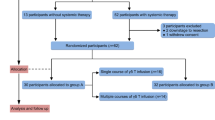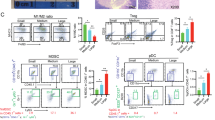Abstract
This study's goal was to assess the safety of tumor-targeted interleukin-12 (ttIL-12) when administered by electrogenetherapy in C3H/HeJ mice by identifying an initial safe dose for human dose escalation schemes, toxicity target organs, markers of toxicity, and toxicity reversibility. Tumor-free mice receiving two doses of 0.45% NaCl, 1 μg ttIL-12 DNA in 0.45% NaCl or 5 μg ttIL-12 DNA in 0.45% NaCl, 10 days apart combined with low-intensity electroporation were compared with non-treatment controls over time. All mice had blood cell counts, serum chemistry profiles, plasma interleukin-12 and IFNγ determinations, necropsy and multi-organ histopathology. Mild treatment-associated changes included electroporation-associated muscle changes that resolved by 30 days; decreased total white blood cell counts and infectious disease in the 5 μg ttIL-12 group, but not in the 1 μg group, and liver changes in ttIL-12 groups that correlated with alanine transaminase levels and resolved by 30 days. Dystrophic cardiac calcification seen in older, 5 μg ttIL-12-treated mice was the only serious toxicity. Based on these results and the lack of any effect on wound healing when combined with surgery, low-intensity electrogenetherapy with ttIL-12 appears to be safe and well tolerated.
This is a preview of subscription content, access via your institution
Access options
Subscribe to this journal
Receive 12 print issues and online access
$259.00 per year
only $21.58 per issue
Buy this article
- Purchase on Springer Link
- Instant access to full article PDF
Prices may be subject to local taxes which are calculated during checkout






Similar content being viewed by others
References
Yoshida A, Koide Y, Uchijima M, Yoshida TO . IFN-gamma induces IL-12 mRNA expression by a murine macrophage cell line, J774. Biochem Biophys Res Commun 1994; 198: 857–861.
Tannenbaum CS, Tubbs R, Armstrong D, Finke JH, Bukowski RM, Hamilton TA . The CXC chemokines IP-10 and Mig are necessary for IL-12-mediated regression of the mouse RENCA tumor. J Immunol 1998; 161: 927–932.
Trinchieri G . Interleukin-12: a cytokine produced by antigen-presenting cells with immunoregulatory functions in the generation of T-helper cells type 1 and cytotoxic lymphocytes. Blood 1994; 84: 4008–4027.
Brunda MJ, Luistro L, Warrier RR, Wright RB, Hubbard BR, Murphy M et al. Antitumor and antimetastatic activity of interleukin 12 against murine tumors. J Exp Med 1993; 178: 1223–1230.
Nastala CL, Edington HD, McKinney TG, Tahara H, Nalesnik MA, Brunda MJ et al. Recombinant IL-12 administration induces tumor regression in association with IFN-gamma production. J Immunol 1994; 153: 1697–1706.
Cohen J . IL-12 deaths: explanation and a puzzle. Science 1995; 270: 908.
Leonard JP, Sherman ML, Fisher GL, Buchanan LJ, Larsen G, Atkins MB et al. Effects of single-dose interleukin-12 exposure on interleukin-12-associated toxicity and interferon-gamma production. Blood 1997; 90: 2541–2548.
Carson WE, Yu H, Dierksheide J, Pfeffer K, Bouchard P, Clark R et al. A fatal cytokine-induced systemic inflammatory response reveals a critical role for NK cells. J Immunol 1999; 162: 4943–4951.
Li S, Zhang X, Xia X . Regression of tumor growth and induction of long-term antitumor memory by interleukin 12 electro-gene therapy. J Natl Cancer Inst 2002; 94: 762–768.
Daud AI, DeConti RC, Andrews S, Urbas P, Riker AI, Sondak VK et al. Phase I trial of interleukin-12 plasmid electroporation in patients with metastatic melanoma. J Clin Oncol 2008; 26: 5896–5903.
Heller L, Merkler K, Westover J, Cruz Y, Coppola D, Benson K et al. Evaluation of toxicity following electrically mediated interleukin-12 gene delivery in a B16 mouse melanoma model. Clin Cancer Res 2006; 12: 3177–3183.
Muramatsu T, Nakamura A, Park HM . In vivo electroporation: a powerful and convenient means of nonviral gene transfer to tissues of living animals (Review). Int J Mol Med 1998; 1: 55–62.
Reed SD, Li S . Electroporation advances in large animals. Curr Gene Ther; e-pub ahead of print 1 August 2009.
Li S . Delivery of DNA into tumors. Methods Mol Biol 2008; 423: 311–318.
Trollet C, Scherman D, Bigey P . Delivery of DNA into muscle for treating systemic diseases: advantages and challenges. Methods Mol Biol 2008; 423: 199–214.
Trollet C, Bloquel C, Scherman D, Bigey P . Electrotransfer into skeletal muscle for protein expression. Curr Gene Ther 2006; 6: 561–578.
Fedorov VV, Nikolski VP, Efimov IR . Effect of electroporation on cardiac electrophysiology. Methods Mol Biol 2008; 423: 433–448.
Serafini P, De Santo C, Marigo I, Cingarlini S, Dolcetti L, Gallina G et al. Derangement of immune responses by myeloid suppressor cells. Cancer Immunol Immunother 2004; 53: 64–72.
Kiessling R, Wasserman K, Horiguchi S, Kono K, Sjoberg J, Pisa P et al. Tumor-induced immune dysfunction. Cancer Immunol Immunother 1999; 48: 353–362.
Carrio R, Lopez DM . Impaired thymopoiesis occurring during the thymic involution of tumor-bearing mice is associated with a down-regulation of the antiapoptotic proteins Bcl-XL and A1. Int J Mol Med 2009; 23: 89–98.
Car BD, Eng VM, Lipman JM, Anderson TD . The toxicology of interleukin-12: a review. Toxicol Pathol 1999; 27: 58–63.
Poltorak A, He X, Smirnova I, Liu MY, Van Huffel C, Du X et al. Defective LPS signaling in C3H/HeJ and C57BL/10ScCr mice: mutations in Tlr4 gene. Science 1998; 282: 2085–2088.
Eaton GJ, Custer RP, Johnson FN, Stabenow KT . Dystrophic cardiac calcinosis in mice: genetic, hormonal, and dietary influences. Am J Pathol 1978; 90: 173–186.
Korff S, Riechert N, Schoensiegel F, Weichenhan D, Autschbach F, Katus HA et al. Calcification of myocardial necrosis is common in mice. Virchows Arch 2006; 448: 630–638.
Aherrahrou Z, Doehring LC, Ehlers EM, Liptau H, Depping R, Linsel-Nitschke P et al. An alternative splice variant in Abcc6, the gene causing dystrophic calcification, leads to protein deficiency in C3H/He mice. J Biol Chem 2008; 283: 7608–7615.
Gang DL, Barrett LV, Wilson EJ, Rubin RH, Medearis DN . Myopericarditis and enhanced dystrophic cardiac calcification in murine cytomegalovirus infection. Am J Pathol 1986; 124: 207–215.
Price P, Eddy KS, Papadimitriou JM, Faulkner DL, Shellam GR . Genetic determination of cytomegalovirus-induced and age-related cardiopathy in inbred mice. Characterization of infiltrating cells. Am J Pathol 1991; 138: 59–67.
Lostroh A, Li CH . Deposition induced by hydrocortisone of calcium in the heart tissue of female C3H mice. Nature 1955; 176: 504.
Sparks LL, Rosenau W, Macalpin RN, Daane TA, Li CH . Production of dystrophic calcification of cardiac muscle in mice by hydrocortisone. Nature 1955; 176: 503–504.
Acknowledgements
This investigation was partially supported by the National Institutes of Health under Ruth L Kirschstein T-32 National Research Service Award and R01 grant #R01CA120895. The authors thank Michael Fons of Inovio Biomedical Corp. for supplying the Medpulser electroporator and electrodes used in this study.
Author information
Authors and Affiliations
Corresponding author
Ethics declarations
Competing interests
The authors declare no conflict of interest.
Rights and permissions
About this article
Cite this article
Reed, S., Li, S. Pre-clinical toxicity assessment of tumor-targeted interleukin-12 low-intensity electrogenetherapy. Cancer Gene Ther 18, 265–274 (2011). https://doi.org/10.1038/cgt.2010.77
Received:
Revised:
Accepted:
Published:
Issue Date:
DOI: https://doi.org/10.1038/cgt.2010.77
Keywords
This article is cited by
-
Pre-clinical investigation of the synergy effect of interleukin-12 gene-electro-transfer during partially irreversible electropermeabilization against melanoma
Journal for ImmunoTherapy of Cancer (2019)
-
IL-12 based gene therapy in veterinary medicine
Journal of Translational Medicine (2012)



